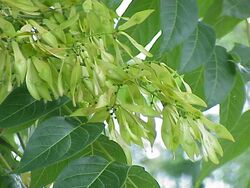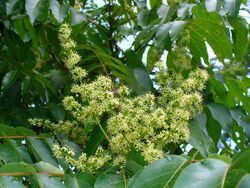Biology:Ailanthus
| Ailanthus | |
|---|---|

| |
| Ailanthus altissima leaf and fruit | |
| Scientific classification | |
| Kingdom: | Plantae |
| Clade: | Tracheophytes |
| Clade: | Angiosperms |
| Clade: | Eudicots |
| Clade: | Rosids |
| Order: | Sapindales |
| Family: | Simaroubaceae |
| Genus: | Ailanthus Desf. |
| Species | |
|
See text | |
| Synonyms[1] | |
| |
Ailanthus (/əˈlænθəs/;[2] derived from ailanto, an Ambonese word probably meaning "tree of the gods" or "tree of heaven")[3] is a genus of trees belonging to the family Simaroubaceae, in the order Sapindales (formerly Rutales or Geraniales). The genus is native from east Asia south to northern Australasia.
Selected species

The number of living species is disputed, with some authorities accepting up to ten species, while others accept six or fewer. Species include:
- Ailanthus altissima (Mill.) Swingle (tree of heaven, syn. A. vilmoriniana Dode[4]) – northern and central mainland China, Taiwan. Invasive in North America, Europe, Britain, and Australia.[5][6] Serves as central metaphor in A Tree Grows in Brooklyn.
- Ailanthus excelsa Roxb. – India and Sri Lanka
- Ailanthus fordii Noot. – China
- Ailanthus integrifolia Lam. – New Guinea and Queensland, Australia
- Ailanthus triphysa (Dennst.) Alston (white siris syn. A. malabarica[7]) – India, South-east Asia and Australia
- Ailanthus vietnamensis H.V.Sam & Noot. – Vietnam
There is a good fossil record of Ailanthus with many species names based on their geographic occurrence, but almost all of these have very similar morphology and have been grouped as a single species among the three species recognized:[8]
- Ailanthus tardensis Hably – from a single locality in Hungary
- Ailanthus confucii Unger – Tertiary period, Europe, Asia, and North America
- Ailanthus gigas Unger – from a single locality in Slovenia
- Ailanthus pythii Unger – known from the Miocene of Iceland, Styria in Austria and the Gavdos island in Greece
- Ailanthus kurzii Prain – endemic to the Andaman Islands, India
Ailanthus silk moth
A silk spinning moth, the ailanthus silkmoth (Samia cynthia), lives on Ailanthus leaves, and yields a silk more durable and cheaper than mulberry silk, but inferior to it in fineness and gloss. This moth has been introduced to the eastern United States and is common near many towns; it is about 12 cm across, with angulated wings, and in color olive brown, with white markings.[3] Other Lepidoptera whose larvae feed on Ailanthus include Endoclita malabaricus.
See also
References
- ↑ Ailanthus Desf. Plants of the World Online. Retrieved 8 August 2023.
- ↑ Sunset Western Garden Book, 1995:606–607
- ↑ 3.0 3.1
 One or more of the preceding sentences incorporates text from a publication now in the public domain: Chisholm, Hugh, ed (1911). "Ailanthus". Encyclopædia Britannica. 1 (11th ed.). Cambridge University Press. p. 437.
One or more of the preceding sentences incorporates text from a publication now in the public domain: Chisholm, Hugh, ed (1911). "Ailanthus". Encyclopædia Britannica. 1 (11th ed.). Cambridge University Press. p. 437.
- ↑ "The Plant List – Ailanthus vilmoriniana". http://www.theplantlist.org/tpl/record/kew-2626859.
- ↑ "Invasive species of Oxfordshire". BBC Oxford. 23 March 2010. http://news.bbc.co.uk/local/oxford/hi/people_and_places/nature/newsid_8582000/8582535.stm.
- ↑ "National Invasive Species Information Center (NISIC): Gateway to invasive species information; covering Federal, State, local, and international sources.". https://www.invasivespeciesinfo.gov/profile/tree-heaven.
- ↑ "The Plant List – Ailanthus malabarica". http://www.theplantlist.org/tpl/record/tro-50126836.
- ↑ Corbett, S.L.; Manchester, S.R. (2004). "Phytogeography and Fossil History of Ailanthus (Simaroubaceae)". International Journal of Plant Sciences 165 (4): 671–690. doi:10.1086/386378.
- "Ailanthus Desf.". Australian Plant Name Index (APNI), IBIS database. Centre for Plant Biodiversity Research, Australian Government. http://www.anbg.gov.au/cgi-bin/apni?taxon_id=25309.
- Germplasm Resources Information Network: Ailanthus
- Plant Conservation Alliance's Alien Plant Working Group: Least Wanted
Wikidata ☰ Q160580 entry
 |

